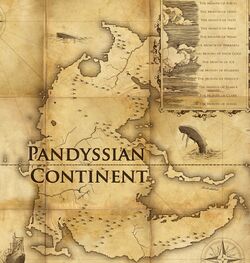
Map of the Pandyssian Continent.
The Pandyssian Continent, also known as the "Far Continent", is the largest known landmass in the world of Dishonored. It remains largely unpopulated, though in reality – and contrary to the belief of Isles inhabitants – trader and merchant cultures dot the edges of the continent.[1]
Details
Similar to Dunwall, the continent was once inhabited by ancient civilizations that built temples and shrines, and possibly practiced the use of magical charms and runes. Much of Pandyssia's population, as of today, is presumably far more primitive to the industrialized Isles – the Abbey of the Everyman believes that the people of Pandyssia are nothing but brutal subhumans that engage in strange and heretical rituals.
The wildlife of Pandyssia is also bizarre and has bewildered even the most esteemed natural philosophers of the Isles – Anton Sokolov made note of strange fish with poisonous quills that jump out of the water during an expedition to the continent, and there have been reports of large flying serpents in the area. Another, more infamous example is the Pandyssian bull rat, which can consume a human being in seconds. These rats are carriers of the rat plague.
As of now, the continent is undergoing a slow process of exploration by expeditions from the Isles. The journey is difficult, even with the new technologies, due to the great distance involved. Similarly, a strange and violent ecosystem, as well as inhospitable terrain, have virtually prevented colonization. However, trading settlements do exist along the outer edges on the continent.
Attempts at exploring and researching the interior have ended in catastrophe, with survivors driven to insanity by the experience – Vera Moray was one such example, and it is possible that Sokolov was introduced to the Outsider during his expedition.
The bulk of the continent is unexplored stretches of lethal desert and jungle. The Academy of Natural Philosophy believes that the rat plague may have originated there, which is confirmed by an audiograph recorded by Hiram Burrows. A poem translated from Old Serkonan also makes mention of a deadly "disease from the East", further solidifying this theory and suggesting knowledge of the plague has existed for decades, if not centuries.
